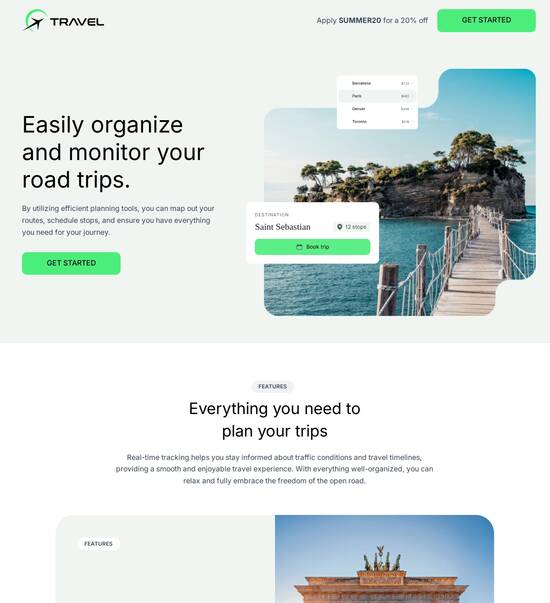
Minimalist 404 error page template
Explore Similar TemplatesAbout template
Unleash your creativity with the minimalist 404 error page template. Try Instapage today.
Recommended templates

Easy to build without coding
With the intuitive drag-and-drop builder, anyone on your team can create high-converting pages without any knowledge of code or design. Make enhancements to your landing page with custom widgets using Javascript, HTML/CSS, or third-party scripts.

Multiple layouts for any industry and goal
Select from 500+ landing page layouts built to boost conversions across industry-specific scenarios. Customize them by adjusting fonts, adding images, and generating on-brand content with the AI assistant. Quickly scale with Instablocks® and Global Blocks that you can save, reuse, and update globally.

Loads fast and looks polished on any device
Every template is responsive, which means they present professionally on any device and load blazingly fast with our Thor Render Engine. You can also power them up with Google AMP technology to deliver an unparalleled mobile experience and drive higher conversions.

Robust analytics & experimentation
Get real-time updates and reporting across all your devices, showing the number of visitors, conversions, cost-per-visitor, and cost-per-lead. Launch AI-powered experiments, run A/B tests, and use heatmaps to analyze user behavior, then optimize your landing page to maximize conversions.







Easy to build without coding
With the intuitive drag-and-drop builder, anyone on your team can create high-converting pages without any knowledge of code or design. Make enhancements to your landing page with custom widgets using Javascript, HTML/CSS, or third-party scripts.
Multiple layouts for any industry and goal
Select from 500+ landing page layouts built to boost conversions across industry-specific scenarios. Customize them by adjusting fonts, adding images, and generating on-brand content with the AI assistant. Quickly scale with Instablocks® and Global Blocks that you can save, reuse, and update globally.
Loads fast and looks polished on any device
Every template is responsive, which means they present professionally on any device and load blazingly fast with our Thor Render Engine.
Robust analytics & experimentation
Get real-time updates and reporting across all your devices, showing the number of visitors, conversions, cost-per-visitor, and cost-per-lead. Launch AI-powered experiments, run A/B tests, and use heatmaps to analyze user behavior, then optimize your landing page to maximize conversions.
All the features you need to build lead-generating landing pages
Explore more featuresLearn how to build top-performing landing pages for any goal
FAQs
Leading the way in building high-performing landing pages





Maximize your campaigns with instapage's landing page and CRO platform
Instapage stands out as a comprehensive solution for marketers looking to enhance their digital marketing effectiveness. With its powerful suite of tools, Instapage helps you create, optimize, and manage landing pages tailored to your unique audience, maximizing return on investment (ROI) and streamlining conversion rate optimization (CRO). By leveraging its robust features, businesses in diverse sectors such as tech, finance, education, and more can elevate their marketing strategies and find success in the competitive online landscape.
Understanding the value of landing pages
Landing pages play a vital role in digital marketing campaigns. They serve as the conversion point where visitors can learn more about your offerings and take action. Instapage provides a variety of capabilities designed to facilitate high conversions, including:
- 100+ high-converting templates: Choose from a wide range of pre-built designs that cater to various industries and purposes.
- Advanced customization tools: Use drag-and-drop functionality to easily tailor your pages to match your brand or campaign requirements.
- Integrated lead generation elements: Incorporate forms, calls-to-action, and other essential elements directly into your landing pages.
Step 1: Create compelling landing pages
Beginning your journey with an effective landing page is simple. Follow these steps:
- Select a template: Choose from Instapage's library of templates designed to capture leads effectively while aligning with your brand aesthetics.
- Customize your page: Use the intuitive editing tools to add your branding, messages, and lead capture elements to make the page yours.
- Preview and publish: Ensure your final landing page looks great on all devices before hitting publish.
Step 2: Optimize for conversions
To ensure maximum effectiveness, you need to keep refining your landing pages based on real user interactions. Here are key activities:
- Utilize A/B testing: Run experiments to determine which headlines, images, and calls-to-action yield the best results.
- Leverage heatmaps: Analyze on-page behavior to understand how users interact with your page and make data-driven adjustments.
- Track analytics: Monitor conversions and performance through Instapage's built-in analytics dashboard to continuously enhance user experience.
Step 3: Personalize content for your audience
Creating personalized content is crucial for engaging with diverse audience segments. Addressing user-specific needs can improve conversion rates significantly:
- Dynamic text replacement: Automatically customize page text based on user inputs or ad campaigns to create a cohesive experience.
- Using AdMaps: Align targeted ads with specific landing pages to ensure a seamless transition from click to conversion.
- Audience analytics: Monitor how different segments interact with your content to tailor future approaches effectively.
In today's fast-paced digital environment, Instapage offers marketers the essential capabilities to create and nurture landing pages optimized for conversion. Through strategic experimentation and continuous learning, you can improve the effectiveness of your campaigns over time.
Ready to elevate your marketing campaigns? Discover how Instapage can transform your digital marketing strategies into a highly efficient, results-driven approach tailored to your unique needs and goals.
People also ask about Minimalist 404 error page template
Minimalist 404 error page template: A comprehensive guide
Understanding minimalist 404 error pages: A design perspective
A 404 error page is a standard HTTP response code indicating that the server could not find the requested resource. Typically, elements such as the URL or a link might be incorrect, resulting in the user encountering a message letting them know that the page they were searching for can't be found. These pages are critical in the user experience landscape because they offer an opportunity to guide users back to relevant content rather than leaving them in a frustrating digital dead-end.
In recent years, minimalist design has gained significant momentum in creating digital experiences. By stripping away unnecessary elements, minimalist design focuses on core functionality while delivering a visually appealing layout. This trend elevates the user navigation experience, making it vital for brands to understand its application, especially in crafting an effective 404 error page.
Features of a minimalist 404 error page template
A minimalist 404 error page template should prioritize clarity and simplicity. By utilizing white space effectively, designers can create a clean and efficient environment, making it easier for users to navigate away from the error they encountered. Clear messaging also plays a vital role, as users need to understand quickly that they have reached a dead end and what their next steps should be.
Visual elements are another essential component. Incorporating engaging graphics or images can lighten the mood of an error page, creating a more pleasant user experience despite the hiccup. Illustrating the error creatively can help reinforce the brand without overwhelming users.
Clarity and simplicity
Engaging visual elements
Interactive components like CTAs and search functionality
Responsiveness across devices
Crafting an effective 404 error message
The tone and voice of the 404 message are crucial in reflecting the brand's personality. A lighthearted tone may help ease the user's frustration, while a more serious approach might be fitting for professional or formal brands. It's essential to find the right balance so that users feel engaged rather than alienated.
Providing alternatives is also vital. Link to the homepage or other relevant pages, guiding users back to areas of the website that may interest them. Suggestions for further exploration can keep users on the site, turning a frustrating experience into an opportunity for engagement.
The role of collections and pages in minimalist design
Organizing error pages within collections can further enhance user navigation. By structuring error pages systematically, you ensure consistency and clarity in design, making it easier for users to decide what to do next when they hit a 404 error.
Designing a user-centric navigation flow is crucial for facilitating user journeys. When a user encounters a 404 page, they should feel that the website recognizes their predicament and offers a path back to relevant content.
Innovations in the design of minimalist 404 error pages
Color and typography are powerful tools in minimalist design. Opt for color palettes that calm and engage users, avoiding overwhelming combinations that may distract from the message. Typography plays a significant role in clarity and readability, making it easier for users to understand their options.
Incorporating subtle animations and micro-interactions can also heighten user engagement. However, it is essential to strike a balance between minimalism and interactivity. Overly animated error pages can detract from the essential message, making the user experience cumbersome.
Case studies: Success stories of minimalist 404 error pages
Examining brands with exemplary error pages can provide valuable insights into what works. The top performers in this realm often feature user-friendly designs, incorporating humor and empathy into their messages while also offering intuitive navigation paths back into their sites.
User feedback can illuminate how effective these minimalist designs are in engaging users and retaining their interest. By analyzing bounce rates and conversion metrics, brands can gauge the success of their error page strategy.
Implementing a minimalist 404 error page: Step-by-step guide
To begin the design phase, identify the objectives and audience for the error page. Understanding the user demographic can shape design choices and messaging strategies. Next, sketch initial concepts that reflect minimalism while addressing user pain points.
During the development phase, various tools and technologies exist to create templates. HTML/CSS offers robust options to ensure your error page is minimal yet effective. Additionally, testing and optimization are vital. Analyzing how users interact with the page can provide insights for A/B testing, leading to improvements over time.
Tools and resources for crafting your minimalist 404 error page
Several design software options can aid in creating customized graphics that resonate with the brand’s minimalistic style. Graphic design tools ensure that image quality aligns with overall design aesthetics, while prototyping tools will help test layout effectiveness before finalizing.
Additionally, various code libraries and frameworks exist to implement minimalist styles effectively. Utilizing CSS libraries can significantly streamline your design process, ensuring consistency while enhancing layout appeal.
Future trends in minimalist error pages
As user experience design evolves, we may see further shifts in how 404 pages are developed. Predictions suggest advances in AI could soon personalize error pages based on user behavior, improving the overall navigation experience and minimizing frustration.
Engaging users through personalization will remain a critical focus. In catering experiences to individual users, brands can maintain a personal touch even in moments of error, ensuring that visitor frustrations are met with solutions tailored to their needs.
Summarizing the essential elements for a minimalist 404 error page
In crafting a minimalist 404 error page, designers must focus on balancing aesthetics with functionality. User-centric design choices are paramount for ensuring a seamless experience, even during errors. Making informed design decisions rooted in brand personality, clarity, and accessibility will foster stronger connections with users.
It is also crucial to remain adaptable and stay updated with ongoing design trends. By emphasizing feedback loops for continuous improvement, brands can refine their error pages, transforming a frustrating experience into an opportunity for greater engagement.
Ready to skyrocket conversions?
Supercharge your ad campaigns with high-performing landing pages
Get started














